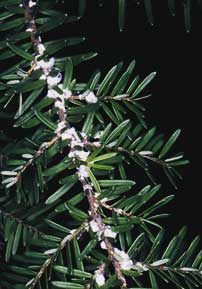|
|
|
|
Adelgids
-
Some
don't even look like insects!
-
|
Summary: These
small, sap-sucking insects are important pests in
forests, landscapes, and Christmas tree
plantations. Some are very difficult to control
because of a waxy protective covering that they
hide under.
Jack DeAngelis, PhD
OSU Ext. Entomologist
(ret.)
my resume
|
|
What are adelgids?
Adelgids are aphid-like insects in the
genus Adelges (family Adelgidae) that feed
mainly on conifers. Conifers are trees and
shrubs that bear cones such as pine, spruce,
hemlock, Douglas-fir, true fir, and many other
valuable landscape and forest species. Like
aphids, adelgids feed by tapping into their host
plants and withdrawing plant sap. Infestations can
cause branch dieback, growth deformation and in
severe outbreaks even death of the host plant.
Entire forests can be killed by certain adelgids
such as the hemlock woolly adelgid (see photo
right).
Adelgids can be important pests in
landscapes, plant nurseries, Christmas tree
plantations and forests. Since both aphids and
adelgids tend to be somewhat host
plant-specific, adelgid identification
usually begins with correct identification of the
host tree or shrub (see below).
Adelgids usually cover themselves with a
waxy coating (right). This wax can make mature
adelgids very difficult to control with spray-type
insecticides. The best control strategy is to
treat the young, unwaxed, stages with an overhead
spray such as insecticidal soap then treat waxed
stages with a systemic insecticide like
imidacloprid (see Merit
Insecticide).
|
 |
hemlock woolly adelgid (Adelges
tsugae); the adelgids are covered
with white wax
|
|
|
Tree identification
If you know what kind of tree you have use
the table below to identify the respective adelgid
and aphids pests. If you are unsure of your plant's
identification use this tree identification key from
Oregon State University. Use the "dichotomous
key" link to identify an unknown. Once you know the
plant, use the table below to identify the aphids
and adelgids that can infest your type of plant.
|
|
Control of aphids & adelgids
Healthy trees and shrubs can usually
tolerate a fair number of these pests without much
damage. Therefore, your first efforts should be to
create healthy plants through proper water,
fertilizer and soil management.
If populations are high and damaging,
unwaxed aphids can be effectively controlled with a
strong overhead spray of plain water from the garden
hose followed by treatment with insecticidal soap
(see Using
Insecticidal Soap to Control Aphids). You may
need to repeat this several times during the summer
because the soap has no residual activity.
Waxy, mature adelgids should be treated
with a systemic insecticide like imidacloprid (see
above). This insecticide moves around in the plant's
vascular system and poisons aphids or adelgids when
they feed
|
|
How to identify aphids and adelgids on some
conifers
The table below can help you identify some
of the aphids and adelgids on Douglas-fir, true
firs and spruce. Because these insects
are somewhat host plant specific it is sometimes
possible to base identification on the host plant
itself. The table lists only some of the more common
aphid and adelgids that can be found on these trees.
|
|
|
|
Douglas-fir (Pseudotsuga
menziesii)
|
|
Large, dark colored
aphids without waxy covering. Produce large amounts of
honeydew which may attract yellowjackets and ants.
===>
|
conifer
aphids (Cinara sp.)
|
|
Small, dark "crawlers" on
needles in late spring and/or white cottony tufts of
wax on needles before bud break or after mid-June.
===>
|
Cooley
spruce gall adelgid (Adelges cooleyi)
|
|
|
True firs (Abies
sp.)
|
|
Large, dark colored
aphids without waxy covering. Produce large amounts of
honeydew which may attract yellowjackets and ants.
===>
|
conifer
aphids (Cinara sp.)
|
|
Swelling of branch nodes
caused by very small, waxy adelgids. Trunk and
branches covered with patches of white, waxy material.
===>
|
balsam
woolly adelgid (Adelges piceae)
|
|
Twisting of new needle
growth. Small greenish yellow or larger bluish gray
(stem mother) aphids. Wax and honeydew produced by
aphids may mat needles together and attract
yellowjackets. ===>
|
balsam
twig aphid (Mindarus abietinus)
|
|
|
Spruce (Picea sp.)
|
|
Large, dark colored
aphids without waxy covering. Produce large amounts of
honeydew which may attract yellowjackets and ants.
===>
|
conifer
aphids (Cinara sp.)
|
|
Pineapple-shape galls or
cones on branch tips. ===>
|
Cooley
spruce gall adelgid (Adelges cooleyi)
|
|
Twisting of new needle
growth. Small greenish yellow or larger bluish gray
(stem mother) aphids. Wax and honeydew produced by
aphids may mat needles together and attract
yellowjackets. ===>
|
balsam
twig aphid (Mindarus abietinus)
|
|
Older needles shed,
especially on lower, shaded portions of tree. Aphids
peak in late winter, disappear by summer. Small, green
aphids. ===>
|
spruce
aphid (Elatobium abietinum)
|
|
|
|
References
Conifer
root aphid Prociphilus americanus in Oregon (1998)
This is an unpublished summary used in a 1998 short course.
Note: control suggestions may be outdated in this 1998
paper.
Balsam
Woolly Adelgid & Balsam Twig Aphid This is an
unpublished handout used in a 1998 short course. Basic life
history information. Note: control suggestions may be
outdated in this 1998 paper.
Aphid and
Adelgid Pests of Conifers in Oregon This is an OSU
Extension bulletin that I authored in 1994. This bulletin
covers most of the important aphid and adelgid pests of
conifers with details about life history, monitoring and
control.
|
|
Don't
forget to bookmark us for next time - press ctrl-D
in most browsers.
|
|
|
|
|
Mission: To provide accurate,
up-to-date and unbiased information for solving
common insect and mite problems around your home,
business and landscape using least-toxic methods.
|
|
|
|
Copyright ©
2004-... LivingWithBugs, LLC. All
rights reserved.
|

